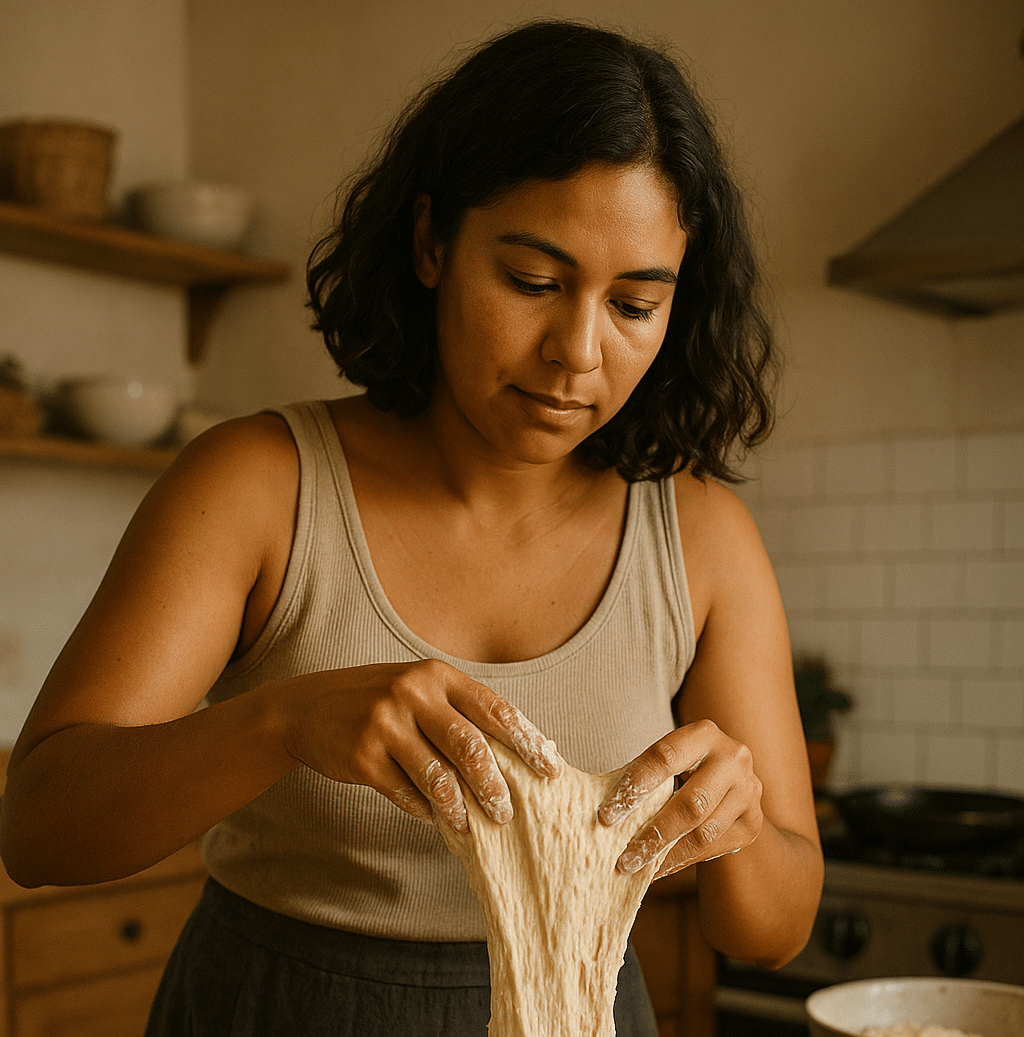Looking for a no starter sourdough recipe that still gives you tangy, crusty, artisan-style bread? You’re not alone. Sometimes, you’re in the mood to bake but haven’t nurtured a starter for weeks. This guide shows you how to make sourdough-style bread without an established starter—and yes, it actually works. We’ll walk through how to substitute starter with wild fermentation or use a shortcut that still brings that classic flavor. From overnight options to baking tips and adapting no-knead recipes, you’ll get everything you need to pull off a flavorful loaf with minimal prep. Let’s dive into the floury magic.
Table of Contents
Why a No Starter Sourdough Recipe Makes Sense
When You Crave Sourdough but Don’t Have Time
I still remember the first time I wanted to bake sourdough but hadn’t fed my starter in weeks. I looked at the jar, sighed, and thought, “There’s got to be another way.” That longing for crackly crust and chewy crumb? It doesn’t go away just because you didn’t plan ahead. That’s where a no starter sourdough recipe steps in—it gives you that classic tang and texture without waiting a week or more. Whether you’re a new baker or just out of sync with your starter’s schedule, you’ll appreciate the flexibility.
You’re essentially crafting a wild ferment on the spot—similar to how a starter is created, but with a shorter goal in mind. This process relies on patience, hydration, and a warm resting place. It’s an invitation to work with nature but on your own timeline. If you’re new to starter-free methods, check out our easy no starter sourdough recipe that breaks down the process in one bowl.
What’s Really Happening When You Skip the Starter
Let’s clear this up: skipping the starter doesn’t mean skipping fermentation—it just means building it differently. A no starter sourdough recipe depends on either a pre-ferment (like a poolish) or a slow bulk rise that mimics the microbial activity of a mature starter. This means you still get that depth of flavor, airy structure, and satisfying chew.
Technically, you’re encouraging wild yeast and bacteria directly in the dough mix, typically over 12 to 24 hours. It’s similar to how old-world bakers made bread before commercial yeast existed. Want to go more hands-off? You can adapt your no knead sourdough routine by extending the fermentation time. And yes, you’ll still need flour, water, salt, and some time—but no discard, no feeding schedules, and no stress.
How to Make Sourdough Without a Starter (Two Reliable Methods)
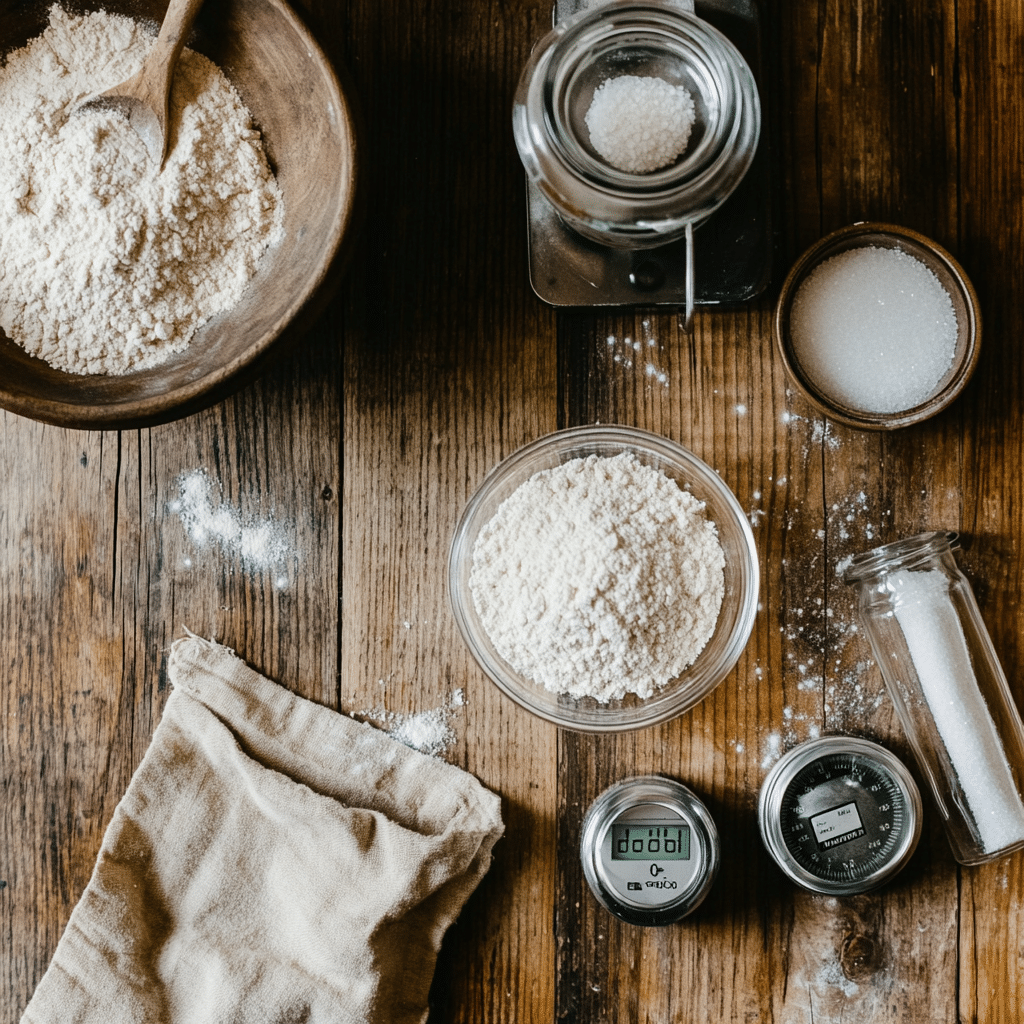
Wild Fermentation: Starting from Scratch in the Dough
If you’re committed to no commercial yeast, the wild fermentation route is the closest you’ll get to traditional sourdough without a starter. Here’s how it works: you mix flour and water and let it sit—usually overnight—so naturally occurring yeast and bacteria begin developing right in the dough. This process requires warmth, hydration, and a touch of trust.
Use a 90% hydration level for a strong head start (e.g., 500g flour to 450g water), then stir in your salt the next day once it’s bubbly. You’ll notice signs of fermentation—small bubbles, a slightly sour smell, and a looser texture. From there, fold the dough every 30 minutes for 2–3 hours before a long rise and bake. It’s slower than commercial yeast, but the reward is a deep, rustic flavor and incredible texture.
IA method similar to our sourdough pretzel bread relies on long, slow fermentation for deep flavor.
Fast-Track Option: Use a Pinch of Yeast to Kickstart Flavor
If you’re short on time but still want that tangy, complex flavor, adding just a small pinch (⅛ teaspoon) of instant yeast to a high-hydration dough can work wonders. This hybrid method relies on long fermentation—typically 12–18 hours at room temperature or in the fridge overnight—to develop the rich notes of sourdough.
This method is ideal for adapting a no knead bread recipe into a sourdough-style loaf without an established starter. You’ll mix your dough, let it rest covered overnight, and then fold, shape, proof, and bake. It’s reliable, forgiving, and flavorful—even for first-time bakers.
You still get that crisp crust and open crumb, but without needing a live culture. It’s perfect for weeknight prep: mix before bed, bake the next evening, and wow your kitchen with that unmistakable sourdough aroma.
Shaping and Baking Your No Starter Sourdough Like a Pro
Proofing Without a Starter: What to Watch For
Proofing without a starter requires a bit of intuition. Since your dough doesn’t have a mature colony of yeast and bacteria to rely on, you’ll need to pay close attention to time, temperature, and visual cues. After your bulk fermentation (whether via wild ferment or a pinch of yeast), your dough should feel noticeably airier, with visible bubbles along the surface.
Unlike traditional sourdough, which often doubles in volume before shaping, no starter sourdough dough may rise a little less. That’s okay. What you’re really looking for is elasticity, bounce, and bubbles—not just size. To check if your dough is ready for shaping, gently press it with a fingertip. If the indentation springs back slowly, it’s time.
This is also the moment to prepare your proofing basket or bowl. If you’re a fan of whole grain sourdough, you can dust the basket with whole wheat or rye flour for a hearty finish. This shaping method also works great for high-hydration doughs like sourdough ciabatta.
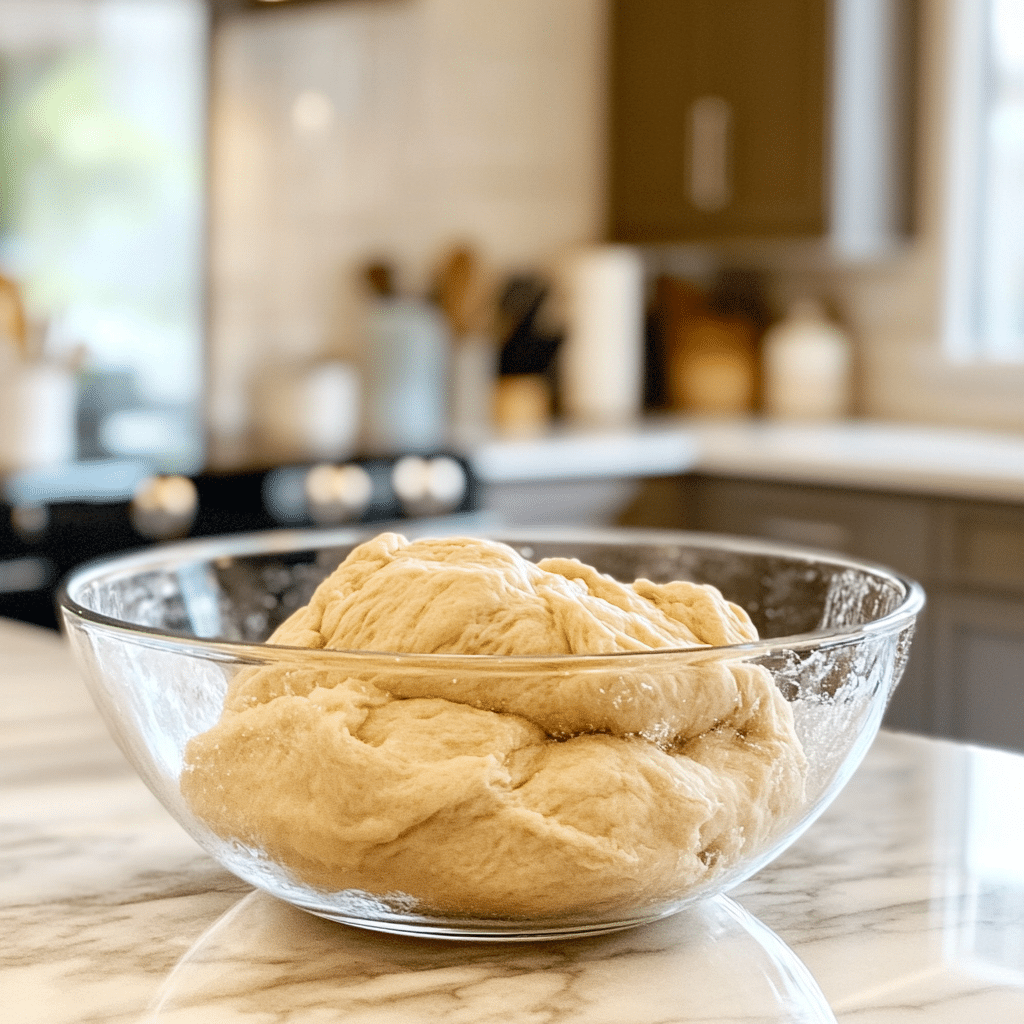
Baking Tips for a Crackling Crust and Chewy Interior
A high-hydration dough (75–90%) benefits greatly from steam during baking. Preheat your oven to 475°F (245°C) with a Dutch oven inside. Once your dough is proofed and shaped, gently place it into the hot pot, score it with a razor or lame, and cover it. Bake for 20 minutes with the lid on, then another 20–25 minutes uncovered for deep color.
Want a darker crust? Extend the final uncovered bake by 5–10 minutes or let the loaf cool completely in the oven with the door cracked slightly. The result is a golden, blistered crust that shatters as you cut. Inside, expect a moist, chewy crumb—lightly sour, nutty, and full of character.
This technique mirrors what you’d use with a sourdough Dutch oven loaf, but the beauty is—you got there without babysitting a starter for days. It’s pure satisfaction in a cast iron pot.
Customizing, Storing & Troubleshooting Your No Starter Sourdough
Add-Ins and Variations for Flavor Boosts
Once you’ve got the hang of a basic no starter sourdough recipe, you can start experimenting with add-ins that complement its naturally tangy flavor. Chopped walnuts and dried cranberries bring a sweet-savory balance, while roasted garlic or olives give your loaf a Mediterranean flair. Just fold these ingredients in after your first stretch-and-fold or during shaping to maintain structure.
You can also swap out 10–30% of your flour for whole wheat, spelt, or rye to create a richer flavor and darker crumb. If you’re used to baking from easy sourdough discard recipes, you’ll find the method familiar. No starter doesn’t mean no creativity—treat each loaf like a new canvas.
For a sweet twist, try a cinnamon swirl version using brown sugar, cinnamon, and butter. Spread it before shaping and roll it tight. You won’t believe it’s made without a traditional starter.
How to Store, Reheat, and Save Your Loaf
Once baked and cooled, your sourdough will stay fresh on the counter for 2–3 days wrapped in a clean towel or stored in a paper bag. For longer storage, slice and freeze the loaf, separating slices with parchment paper. Reheat in a toaster or 375°F oven for 5–8 minutes for that fresh-baked feel.
If your crust softens overnight (as it often does), refresh it in the oven at 400°F for 5–7 minutes. It’s also helpful to store cut-side down on a wooden board to keep it from drying out too quickly.
Having trouble getting that open crumb or crust? Check your hydration. Too little water results in a dense loaf; too much, and shaping gets tricky. If you’re following overnight sourdough bread methods, be patient with fermentation—cold rises take longer but yield incredible texture.
Frequently Asked Questions
How can I adapt a no knead bread recipe to sourdough starter or wild ferment?
To adapt a no knead bread recipe to use wild fermentation or starter-free sourdough, extend the rise time significantly—typically 12–18 hours at room temperature or overnight in the fridge. If using a pinch of commercial yeast as a jumpstart, go as low as ⅛ teaspoon. The long fermentation builds that sour flavor naturally, even without a traditional starter.
Can I make overnight sourdough bread without a starter?
Absolutely. Mix your dough with flour, water, salt, and a tiny amount of yeast—or none at all—and let it ferment overnight. This extended time allows natural yeast and bacteria to develop in the dough, producing a loaf with a flavor and texture remarkably similar to traditional sourdough. Check out our overnight sourdough bread recipe for step-by-step guidance.
Is it possible to make sourdough bread without a starter at all?
Yes, you can. Instead of feeding and maintaining a starter, you create a spontaneous ferment by mixing flour and water and letting nature do its thing. This dough sits for 12–24 hours, during which natural yeast and bacteria develop. The result is a naturally leavened bread with that iconic tang—no starter required.
How do I bake sourdough bread if I don’t have a starter?
Mix your ingredients and allow the dough to ferment slowly. Then shape, proof, and bake in a Dutch oven for best results. Steam and high heat are essential for a crusty exterior and soft, chewy interior. This method is similar to Dutch oven sourdough, minus the starter. Focus on hydration, fermentation time, and scoring for oven spring.
Can I still make no knead sourdough bread without a starter?
Definitely. No knead methods pair well with wild fermentation or minimal yeast. Combine your ingredients, let the dough rest undisturbed for 12–18 hours, and follow standard no-knead baking instructions. It’s a forgiving approach and ideal for beginners who don’t want the hassle of feeding a starter.
Conclusion
You don’t need a bubbly jar of starter to enjoy the soul-satisfying crunch and chew of homemade sourdough. With time, intuition, and a little warmth, your kitchen becomes its own micro-bakery. Whether you’re skipping the starter out of curiosity or necessity, this no starter sourdough recipe opens the door to new rhythms and flavors.
From overnight rests to minimal kneading, the methods shared here prove that sourdough isn’t just a recipe—it’s a process that welcomes patience over perfection. So go ahead, bake your loaf, break the crust, and remember: your sourdough story doesn’t have to start with a starter.
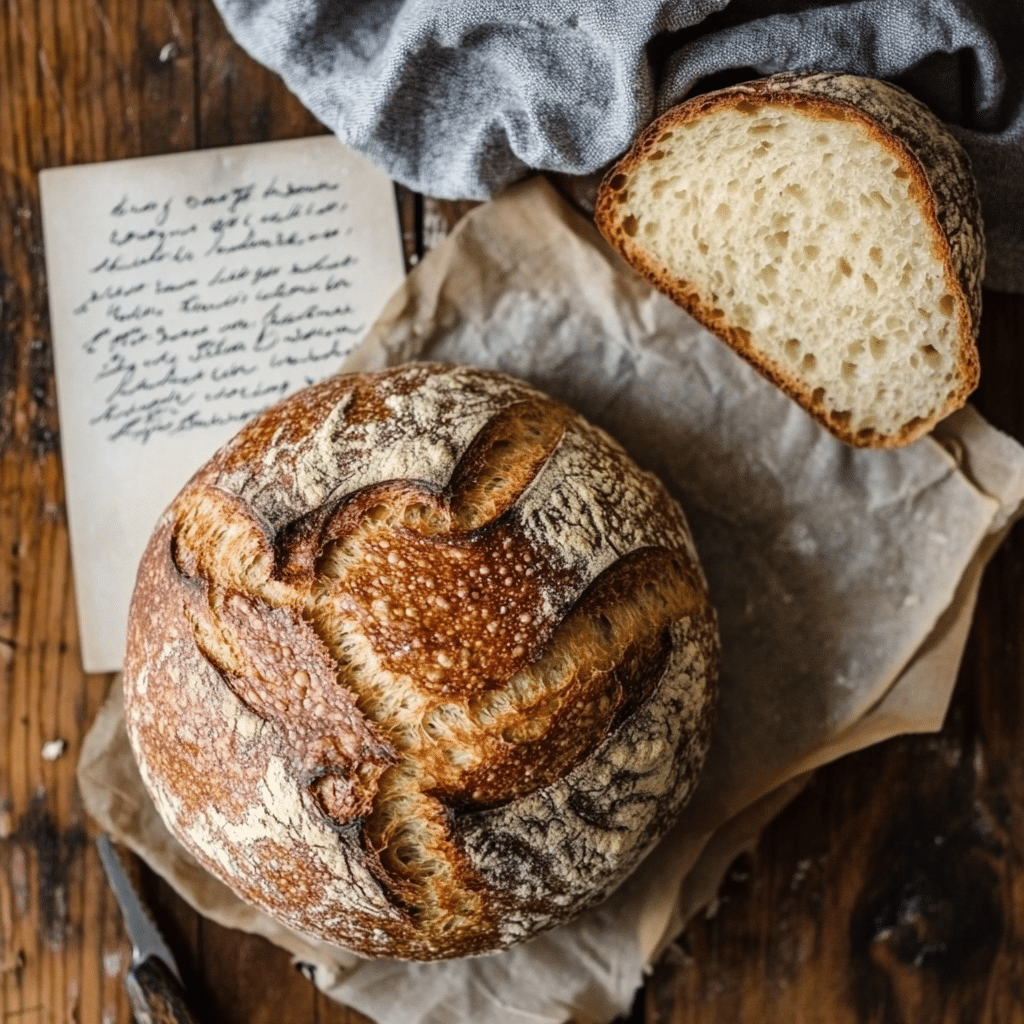
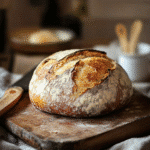
No Starter Sourdough Recipe That Actually Works (And Tastes Amazing)
- Total Time: 13 hours
- Yield: 1 loaf
- Diet: Vegan
Description
A tangy, chewy sourdough-style loaf made without a traditional starter—perfect for spontaneous baking.
Ingredients
500g all-purpose flour
450g water
10g salt
Optional: ⅛ tsp instant yeast (for hybrid method)
Instructions
1. Mix flour and water in a bowl. Let rest for 30 minutes.
2. Add salt (and yeast if using). Mix to combine.
3. Cover and let ferment 12–24 hours at room temp.
4. Perform 3–4 stretch and folds every 30 mins during first 2 hours.
5. Shape dough, place in proofing basket, rest 1–2 hours.
6. Preheat oven to 475°F with Dutch oven inside.
7. Transfer dough to hot Dutch oven, score, and cover.
8. Bake 20 minutes covered, then 20–25 minutes uncovered.
9. Cool on wire rack at least 1 hour before slicing.
Notes
Use whole wheat flour for extra flavor.
Dough may take longer in cooler environments.
Skip yeast entirely for a full wild ferment version.
- Prep Time: 12 hours
- Cook Time: 45 minutes
- Category: Sourdough Bread
- Method: Baking
- Cuisine: Rustic


